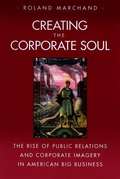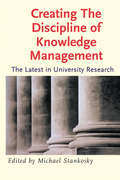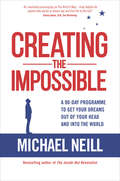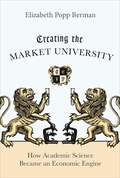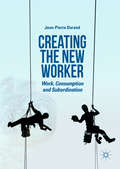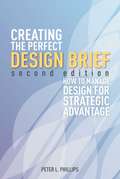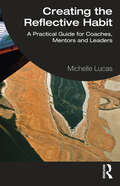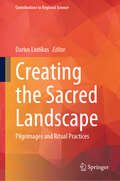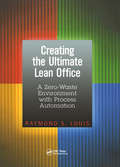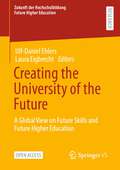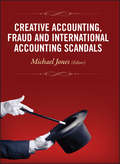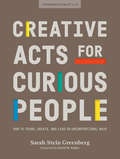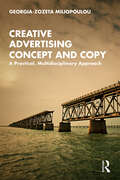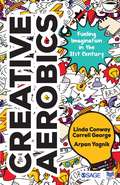- Table View
- List View
Creating the Corporate Soul: The Rise of Public Relations and Corporate Imagery in American Big Business
by Roland MarchandMarchand discusses how some companies came to recognize a need to enhance their social and moral legitimacy, and how they dealt with that realization during the twentieth century.
Creating the Demand Landscape: How Frito-Lay Positioned an Existing Brand to Intersect with Consumers' Daily Life--A New Approach to Measuring Consumer Behavior
by Erich JoachimsthalerRather than segmenting customers according to age, lifestyle, and regional and social characteristics, creating a demand landscape maps the intersection of behavior (activities, projects, tasks, and to-dos driven by goals, needs, urges, sensations, and desires in the social-cultural context) with the capacity of an innovation to fit in and embed itself in the way in which people operate every day. This chapter provides a step-by-step guide to creating a demand landscape for your company.
Creating the Discipline of Knowledge Management: The Latest In University Research
by Michael StankoskyIn this book Dr. Michael Stankosky, founder of the first doctoral program in knowledge management, sets out to provide a rationale and solid research basis for establishing Knowledge Management (KM) as an academic discipline. While it is widely known that Knowledge is the driver of our knowledge economy, Knowledge Management does not yet have the legitimacy that only rigorous academic research can provide. This book lays out the argument for KM as a separate academic discipline, with its own body of knowledge (theoretical constructs), guiding principles, and professional society. In creating an academic discipline, there has to be a widely accepted theoretical construct, arrived at by undergoing scholarly scientific investigation and accompanying rigor. This construct becomes the basis for an academic curriculum, and proven methodologies for practice. Thus, the chapters in this book bridge theory and practice, providing guiding principles to those embarking on or evaluating the merits of a KM program. As a methodology itself for undertaking the development of a body of knowledge, a KM Research Map was developed to guide scholars, researchers, and practitioners. This book presents this map, and showcases cutting-edge scholarship already performed in this nascent field by including the dissertation results of eleven KM scholar/practitioners.
Creating the French Behavioral Insights Team
by Emilie Billaud Michael Luca Ariella KristalThis case explores how neuroscientist Mariam Chammat helped set up the first behavioral insights team at the center of the French government, and encouraged French administrations to innovate and create policy initiatives based on psychological theories of influence and persuasion. Students are asked to assess 35 projects ripe for behavioral intervention and pick the winning proposals.
Creating the Guiding Coalition: Overcoming Barriers to Organizational Change
by John P. KotterBecause major change is so difficult to accomplish, a powerful force is required to sustain the process. A strong guiding coalition is always needed-one with the right composition, level of trust, and shared objective. This chapter was originally published as Chapter 4 of "Leading Change."
Creating the Impossible: How to Get Any Project Out of Your Head and into the World in Less Than 90 Days
by Michael NeillAre you ready to make your dreams come true?Michael Neill is widely recognized as one of the world’s leading life coaches, and his teachings have impacted everyone from housewives to CEOs and from gang members in prison to leaders at the United Nations. For the last decade, he has been sharing the principles that will allow you to create far more than you ever thought possible with far less struggle than you expected.Thousands of people from all over the world have already used the principles behind this 90-day program to reconnect with their creative spark and get their most important ideas and projects out of their head and into the world. Now it’s your turn…What if you could accomplish more than you ever imagined without the constant stress and pressure associated with "high achievement?"What if creating what you want to see in the world isn’t dependent on believing in yourself, or even believing that it’s possible?Whether you want breakthrough results for your business, yourself, or your life, this book will change the way you see yourself as you learn to make the impossible possible!
Creating the Market University: How Academic Science Became an Economic Engine
by Elizabeth Popp BermanWhen science adopts the logic of the marketAmerican universities today serve as economic engines, performing the scientific research that will create new industries, drive economic growth, and keep the United States globally competitive. But only a few decades ago, these same universities self-consciously held themselves apart from the world of commerce. Creating the Market University is the first book to systematically examine why academic science made such a dramatic move toward the market. Drawing on extensive historical research, Elizabeth Popp Berman shows how the government—influenced by the argument that innovation drives the economy—brought about this transformation.Americans have a long tradition of making heroes out of their inventors. But before the 1960s and '70s neither policymakers nor economists paid much attention to the critical economic role played by innovation. However, during the late 1970s, a confluence of events—industry concern with the perceived deterioration of innovation in the United States, a growing body of economic research on innovation's importance, and the stagnation of the larger economy—led to a broad political interest in fostering invention. The policy decisions shaped by this change were diverse, influencing arenas from patents and taxes to pensions and science policy, and encouraged practices that would focus specifically on the economic value of academic science. By the early 1980s, universities were nurturing the rapid growth of areas such as biotech entrepreneurship, patenting, and university-industry research centers.Contributing to debates about the relationship between universities, government, and industry, Creating the Market University sheds light on how knowledge and politics intersect to structure the economy.
Creating the Modular Organization, by Michael Shank
by Stephan H. HaeckelSense-and-respond organizations are modular organizations, and in modular organizations, strategy becomes structure as businesses seek to seize competitive advantage through modularity, using it to customize large numbers of profitable responses to individual customers. In this chapter, Michael Shank defines and describes the modular organization and outlines the choices executives must make when transforming their firms for successful modularity.
Creating the Nazi Marketplace
by S. Jonathan WiesenWhen the Nazis came to power in 1933, they promised to build a vibrant consumer society. But they faced a dilemma. They recognized that consolidating support for the regime required providing Germans with the products they desired. At the same time, the Nazis worried about the degrading cultural effects of mass consumption and its association with "Jewish" interests. This book examines how both the state and private companies sought to overcome this predicament. Drawing on a wide range of sources - advertisements, exhibition programs, films, consumer research, and marketing publications - the book traces the ways National Socialists attempted to create their own distinctive world of buying and selling. At the same time, it shows how corporate leaders and everyday Germans navigated what S. Jonathan Wiesen calls "the Nazi marketplace. " A groundbreaking work that combines cultural, intellectual, and business history, Creating the Nazi Marketplace offers an innovative interpretation of commerce and ideology in the Third Reich.
Creating the New Worker: Work, Consumption and Subordination
by Jean-Pierre DurandThis book explores the relationship between the changing nature of capitalism and the creation of the new worker. In a changing global economy, work - as the activity that structures individuals in capitalism both socially and psychologically - is being undermined. Combining a Gramscian critique of contemporary patterns of capitalist labour control with Lacanian psychoanalysis, Durand examines what kinds of human beings are emerging in and through modern work, or on its margins. Creating the New Worker will be of interest to students and scholars who engage in the sociology and psychology of work, economics, and labour.
Creating the Perfect Design Brief: How to Manage Design for Strategic Advantage
by Peter L. PhillipsIn the only book of its kind, now revised and updated with the latest research on the topic, veteran design consultant Peter L. Phillips offers the tools for success gained from nearly thirty years of developing corporate and brand identity programs. Readers will discover the most effective formats for design briefs, how to structure the best possible team, what distinguishes a great design brief from an adequate one, how to use the brief in project tracking, as a measuring tool, as a means of getting approval for a design solution, and much, much more. By covering all of the essential elements of an effective design brief, this unique and empowering guide will help you to ensure that the goals of your corporate design strategy are met.
Creating the Precondition for Innovation
by Rowan Gibson Peter SkarzynskiWhere does innovation actually come from? In this chapter, the authors begin to demystify the innovation process by identifying three critical preconditions for making breakthroughs happen. Questions to help you assess your organization's innovation capabilities are also provided.
Creating the Productive Workplace: Places to Work Creatively
by Derek Clements-CroomeThe built environment affects our physical, mental and social well-being. Here renowned professionals from practice and academia explore the evidence from basic research as well as case studies to test this belief. They show that many elements in the built environment contribute to establishing a milieu which helps people to be healthier and have the energy to concentrate while being free to be creative. The health and well-being agenda pervades society in many different ways but we spend much of our lives in buildings, so they have an important role to play within this total picture. This demands us to embrace change and think beyond the conventional wisdom while retaining our respect for it. Creating the Productive Workplace shows how we need to balance the needs of people and the ever-increasing enabling technologies but also to take advantage of the healing powers of Nature and let them be part of environmental design. This book aims to lead to more human-centred ways of designing the built environment with deeper meaning and achieve healthier and more creative, as well as more productive places to work.
Creating the Reflective Habit: A Practical Guide for Coaches, Mentors and Leaders
by Michelle LucasReflection is a critical skill which can enhance the quality of our professional and domestic lives. Yet in a world of "busy," reflective practice often falls to the bottom of the list. We are not alone in the struggle to use the pause button well. This book is here to help. The book offers a practical toolkit which shows you how to create a sustainable reflective habit. We begin by exploring the meaning and territory of reflection, drawing from the literature to provide context and understanding. The following chapters contain prompts and exercises which will appeal to different processing preferences. The intention throughout this book is firstly, to show that reflection means so much more than journaling, and secondly, to encourage an appetite for experimentation that results in a desire to reflect on a regular and sustainable basis. We invite you into an immersive experience, playing with the multitude of reflective possibilities on offer. It is only through repeated trial and error, enlightenment and frustration that we will come to create our own reflective habit. Written by a coach and coach supervisor, this practical book is an invaluable resource for helping practitioners, but will also be immensely helpful to anyone and everyone who wants to get their pause button in good working order. The book also provides Learning & Development professionals with a suite of tools and materials to help build the reflective practice skill set in their organisation.
Creating the Sacred Landscape: Pilgrimages and Ritual Practices (Contributions to Regional Science)
by Darius LiutikasThis book explores the enduring significance of sacred landscapes in an increasingly globalized world, with a particular focus on the Christian sacred landscape and its connection to pilgrimage and rituals. Drawing on the latest research, it examines the interplay between global societal changes and historical traditions, offering a rich analysis of how sacred spaces shape and reflect cultural and social identities. Through a multidisciplinary lens encompassing cultural geography, anthropology, sociology of tourism, and religious geography, the book illuminates the role of pilgrimage in fostering community identity and preserving historical continuity. By comparing sacred sites and practices across diverse cultural contexts, it provides readers with a deeper understanding of their universal and localized meanings. This work also offers a comprehensive historical perspective, tracing the evolution of sacred landscapes over time and across regions. Accessible and thought-provoking, it invites readers from various disciplines to engage with the cultural, social, and spiritual dimensions of these powerful spaces.
Creating the Social Venture
by Susan Coleman Dafna KarivSocial entrepreneurship is a growing area, and we frequently hear of new ventures committed to social change. In academia, however, social entrepreneurship has typically been taught as a ‘version’ of entrepreneurship, ignoring the unique structure, challenges and goals of the social venture. In their new book, Coleman and Kariv draw on the latest theory and research to provide boundaries to the definition of social entrepreneurship, discussing both what it is, and what it is not. The book answers several key questions: Who are social entrepreneurs? What is the process for identifying and solving a social need? What are the differences between for-profit and not-for-profit social ventures? What is the role of innovation? How do we develop high performing firms? How do we measure success? The focus on context allows students to appreciate how social entrepreneurship develops and operates in different countries and cultures, lending a global perspective to the book. Combined with rich pedagogy and a companion website, it provides students with all the learning tools they need to grasp this important subject.
Creating the Strategy-Focused Organization
by Robert S. Kaplan David P. NortonRelying on case studies and evidence gathered from over 200 companies, the authors of "The Balanced Scorecard," show how strategy-focused organizations have used The Balanced Scorecard to place strategy at the center of their management processes, focusing and aligning their executive teams, business units, human resources, information technology, and financial resources to their organization's strategy. This chapter introduces the five principles of strategy-focused organizations, from translating your company's strategy to operational terms to making strategy everyone's everyday job to mobilizing change through strong, effective leadership.
Creating the Ultimate Lean Office: A Zero-Waste Environment with Process Automation
by Raymond S. LouisThis book introduces the challenges to apply current methodologies to create a lean office. It describes the system enhancement options that lean practitioner can employ in automating the newly created lean processes and explains each of the seven steps necessary for creating a lean office.
Creating the University of the Future: A Global View on Future Skills and Future Higher Education (Zukunft der Hochschulbildung - Future Higher Education)
by Ulf-Daniel Ehlers Laura EigbrechtThis open access publication presents a global panorama of institutional strategies, academic programs, scholarly insights as well as teaching and learning practices taking stock of the Future Skills Turn taking place in higher education. Future Skills have evolved to be one of the most important priorities for the development of higher education institutions globally. Students and graduates learn how to acquire Future Skills for their lives and careers and for shaping societies towards more sustainable futures. Institutions, teachers and policy makers gain insights into strategies to shape the Future Skills Turn in higher education and create the University of the Future.
Creating the Vital Organization: Balancing Short-Term Profits with Long-Term Success
by Scott M. Brooks Jeffrey M. SaltzmanAre the day-to-day pressures of your business preventing your organization from reaching its full potential? If you are spending the bulk of your time and energy streamlining your operations - squeezing more output from your resources, shaving costs, or pressing for speed – you are risking your organization’s future. Today’s top leaders must balance their daily operations with future-oriented explorations so that their organizations can respond and adapt to any challenges in today’s increasingly competitive and fast-moving environment. Yet focusing on both Current Performance and Future Potential is a tricky balancing act; each is a distinct pursuit that requires different skills, resources, measurements of success, and even time horizons. This book tells stories of strategy, insight, and action, featuring the latest advancements in industrial and organizational science, that will help catapult your organization to success now and in the future.
Creation of the European Union
by Gunnar TrumbullDescribes the emergence of the European Union (EU). Focuses on a critical stage in European integration--the period in the early 1990s when member states negotiated the terms of the Maastricht Treaty. This agreement set in motion the project that would eventually lead to the formation of a single currency. Considers the political and economic conditions that led France, Germany, and Britain to undertake this common project.
Creative Accounting, Fraud and International Accounting Scandals
by Michael J. JonesBusiness scandals are always with us from the South Sea Bubble to Enron and Parmalat. As accounting forms a central element of any business success or failure, the role of accounting is crucial in understanding business scandals. This book aims to explore the role of accounting, particularly creative accounting and fraud, in business scandals. The book is divided into three parts. In Part A the background and context of creative accounting and fraud is explored. Part B looks at a series of international accounting scandals and Part C draws some themes and implications from the country studies.
Creative Acts for Curious People: How to Think, Create, and Lead in Unconventional Ways (Stanford d.school Library)
by Sarah Stein Greenberg Stanford d.schoolWINNER OF THE PORCHLIGHT BUSINESS BOOK AWARD • &“A delightful, compelling book that offers a dazzling array of practical, thoughtful exercises designed to spark creativity, help solve problems, foster connection, and make our lives better.&”—Gretchen Rubin, New York Times bestselling author and host of the Happier podcast In an era of ambiguous, messy problems—as well as extraordinary opportunities for positive change—it&’s vital to have both an inquisitive mind and the ability to act with intention. Creative Acts for Curious People is filled with ways to build those skills with resilience, care, and confidence. At Stanford University&’s world-renowned Hasso Plattner Institute of Design, aka &“the d.school,&” students and faculty, experts and seekers bring together diverse perspectives to tackle ambitious projects; this book contains the experiences designed to help them do it. A provocative and highly visual companion, it&’s a definitive resource for people who aim to draw on their curiosity and creativity in the face of uncertainty. Teeming with ideas about discovery, learning, and leading the way through unknown creative territory, Creative Acts for Curious People includes memorable stories and more than eighty innovative exercises. Curated by executive director Sarah Stein Greenberg, after being honed in the classrooms of the d.school, these exercises originated in some of the world&’s most inventive and unconventional minds, including those of d.school and IDEO founder David M. Kelley, ReadyMade magazine founder Grace Hawthorne, innovative choreographer Aleta Hayes, Google chief innovation evangelist Frederik G. Pferdt, and many more. To bring fresh approaches to any challenge–world changing or close to home–you can draw on exercises such as Expert Eyes to hone observation skills, How to Talk to Strangers to foster understanding, and Designing Tools for Teams to build creative leadership. The activities are at once lighthearted, surprising, tough, and impactful–and reveal how the hidden dynamics of design can drive more vibrant ways of making, feeling, exploring, experimenting, and collaborating at work and in life. This book will help you develop the behaviors and deepen the mindsets that can turn your curiosity into ideas, and your ideas into action.
Creative Advertising Concept and Copy: A Practical, Multidisciplinary Approach
by Georgia-Zozeta MiliopoulouConsidering perspectives on creative advertising through a unique media and communications lens, this book encompasses both the theory and practical tools needed to approach and understand creativity in advertising with an original eye.Drawing from diverse subject areas including Social Anthropology, Narrative Theory, Consumer Psychology, Semiotics and Cultural Studies, Creative Advertising Concept and Copy provides a solid grounding in advertising education away from the traditional business and marketing literature. Notwithstanding the need for independent inspiration and originality, the author guides readers through the entire process of campaign planning, moving from strategy to creative idea to finished piece whilst employing concepts and principles relevant to ‘design thinking’. Taking into account ethics and regulations, the use of text and images, and storytelling across radio, TV and video platforms, readers will come to a holistic understanding of what advertising can (and cannot) do, and how to achieve the best results.Written for students involved in creative advertising as an area of academic research and professional practice, this book will also be of interest to early-career advertising professionals seeking a fresh perspective on their work.
Creative Aerobics: Fueling Imagination in the 21st Century
by Ms Linda Conway George Mr Arpan YagnikCreative Aerobics is an internationally proven technique for producing creative ideas. It works for you regardless of whether you are a left-brained student, a creative writer, an engineer, a copywriter, a businessperson, a gifted writer or an artist, or an advertising or marketing professional. In other words, it is a contemporary, creative process that can work for everybody. Advertising and marketing professionals will find this book particularly helpful in extending their ideation skills, maximizing their creative potential, and reducing their time per assignment. This technique has been tested, both in the classroom and the boardroom. Using this, American and Indian students have received more than 200 local, regional, national, and international awards for their creativity from prestigious competitions such as the AAF ADDY and the International Summit Awards. Advertising professionals, from copywriters to creative directors, have collected several awards such as the Cannes Lions, Clio, Ad Asia Pacific Awards, Media Spikes, One Show, and D&AD Pencils for the memorable and effective campaigns they have created for their agencies using this thought process. This book is for anyone who wants to enhance their creativity! There is no aspect of life where this crucial skill is not utilized…. Get the book and get cracking!
